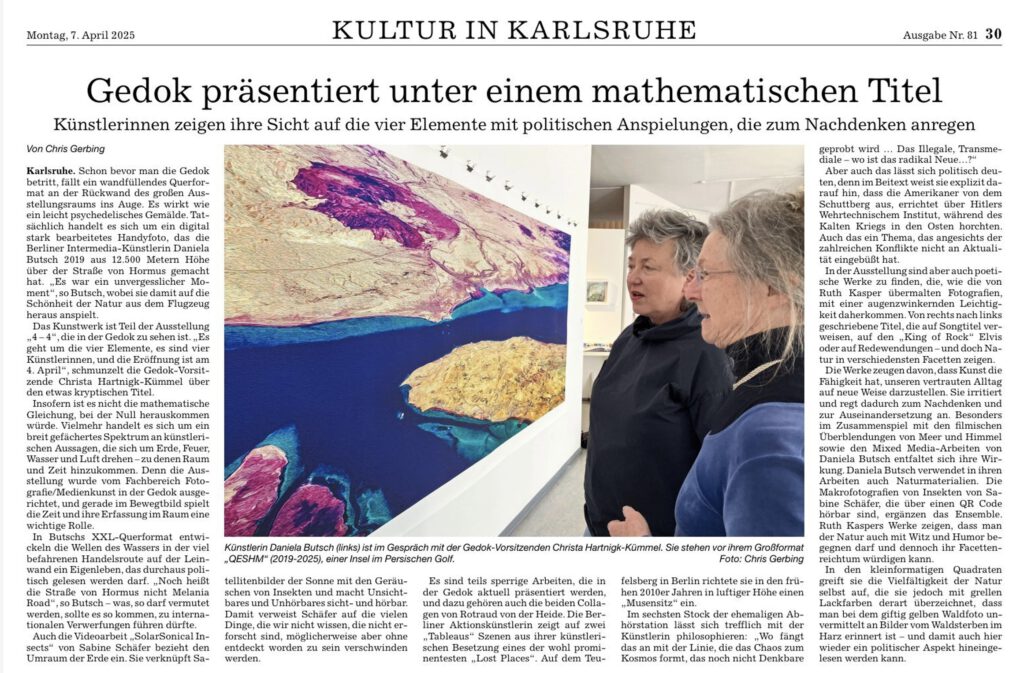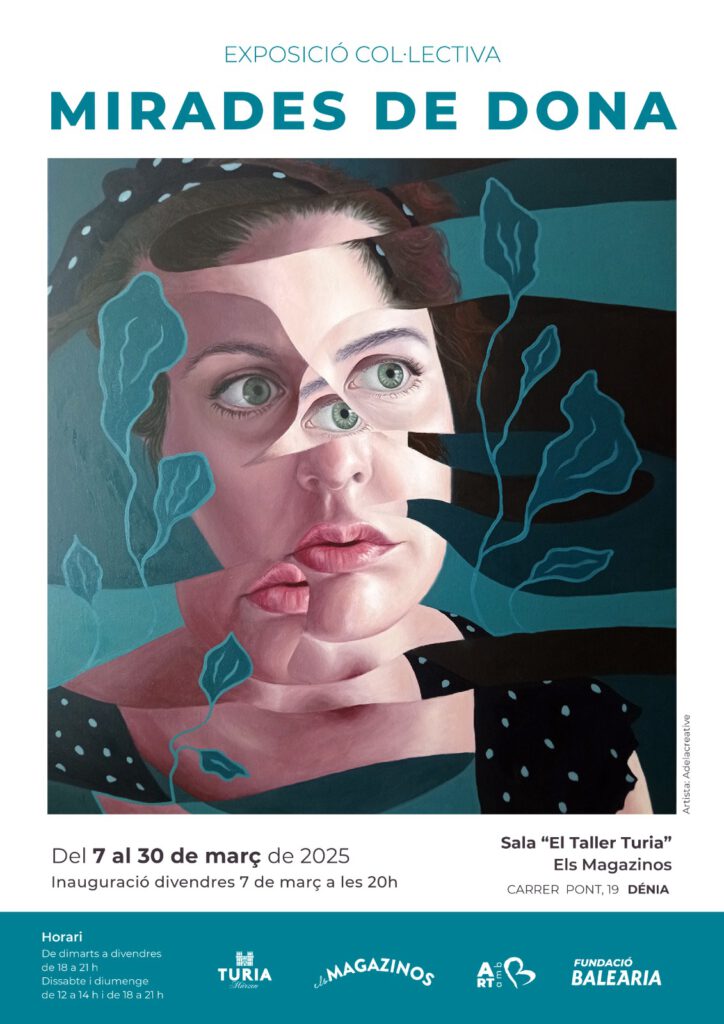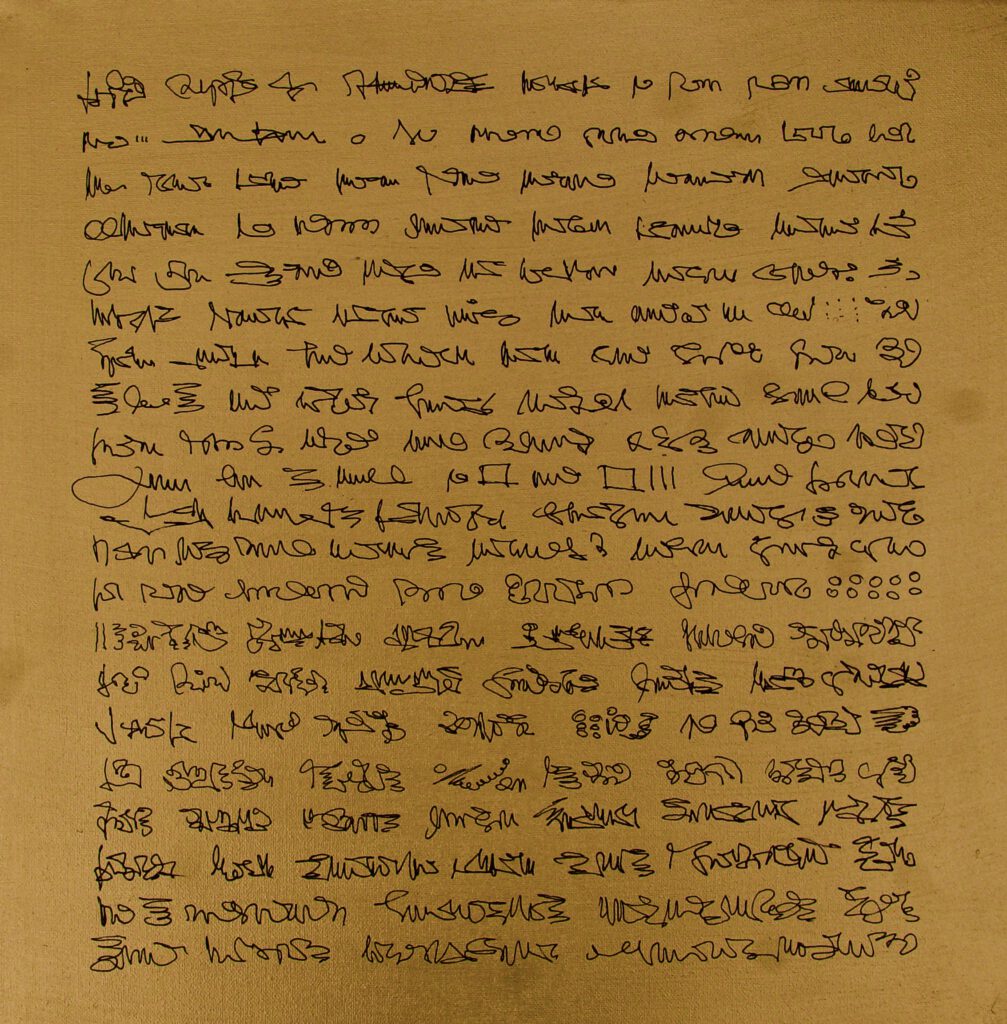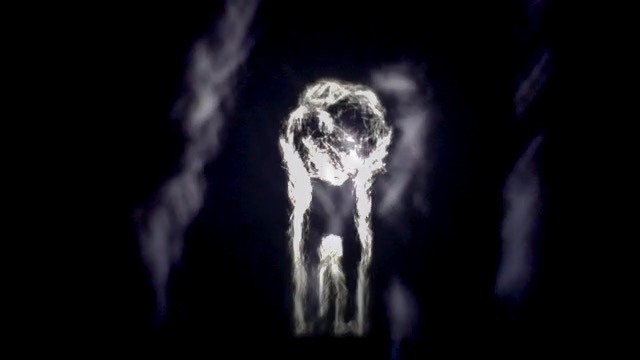The archive is currently being reworked

Speed Manipulation by Daniela Butsch
In this videopiece Daniela Butsch shows a shot of the stern of a ferryboat with the original sounds of the engine and the dispersing water. Recorded sound and the wash of waves are originating from the same energy source, the marine propellers, but are transmitted from different consistencies: air and water. Butsch lets the oscillation of these transmitting media move from different accelerations and decelerations and achieves an astonishing intensity with this minimalistic chronological stylization.
Without reference to proportion and prospective the spatial depth is intentionally decreased and twodimensionality of Butsch’s “electronic painting” is strengthened. The dynamic of disturbance of the water churned up by the marine propellers causes zones of differrent reflections, refractions and filterings of light along the waterway and results in a vertical color-coordinated structure of the painting in anthracite and turquoise tones, pervaded by the white of the spray.
A satisfying floating colour composition turns suddenly into an extremely accelerated acoustic-visual process and vice versa. Picture and sound, which sometimes reminds one of a television with interference and with which Butsch tears the viewer out of inviting meditation and refers back to the technical qualities of her design process.
After an introduction into the spectrum of deformations of time Butsch finishes the sequences with a triple cut of an increasing deceleration. The sound as the most sensitive indicator of the play-back tempo/speed ranges from a deep-frequent noise over a noise at the boundary of the frequency response to the acoustic noise converters and then pitches down into the inaudible range of subsonic noise. In doing so the dispersing water coagulates to an apparent standstill. Like a rockformation, which only changes in geological periods, the achieved condition of aggregation is illusionary. With the previous introduction into the chronological designing process Butsch succeeds with this decisive final sequence in making an conceptual treasure: the potentialities of our perceptive intuition are limited, we can’t apprehend the extremely decelerated change, but we know about it. A knowledge of great wealth of association, it suggests the ability of forming changes, which extend the human horizon of time and perception.
Anke Taryn Schuster, art historian

Qeshm – oder heißt die Strasse von Hormuz im persischen Golf schon Melania road? Donald malt sich seine Welt | Digital photo on canvas134 x 347 cm © DANIELA BUTSCH / VG BILD-KUNST 2019-25
Daniela Butsch, Ruth Kasper, Sabine Schäfer, Rotraud von der Heide. Eine Gruppenausstellung des Fachbereichs Fotografie/Medienkunst
Mit den in dieser Ausstellung gezeigten Arbeiten präsentiere ich die Felder in denen ich mich als Intermedia-Künstlerin bewege:Fotografie | Bewegtbild | Mixed Media, ebenso wie meine eher überzeitlichen Themen: Zeit und Raum – wie ja auch jede Fotografie immer geprägt ist durch ihre doppelte Ausschnitthaftigkeit aus Raum und Zeit.
Qeshm – oder heißt die Strasse von Hormuz im persischen Golf schon Melania road? Donald malt sich seine Welt
Ein komplizierter Untertitel für eine immer komplexere Welt. Ausgangsmaterial für diese Arbeit auf 134 x 347 cm Leinwand ist ein aus ca. 12500 Metern Höhe in 2019 geschossenes Handyphoto auf dem Flug von Rangun nach Doha. Es war ein unvergesslicher Moment aus dieser Höhe unseren wunderschönen blauen Planeten zu sehen, die Strasse von Hormuz mit ihren von Mangrovenwäldern gesäumten Ufern, die pfeilförmige, zum Iran gehörende Insel Qeshm im persischen Golf. Seither wollte ich diese Aufnahme nutzen. Für diese Ausstellung hat mich die politische Erzählung des aktuellen amerikanischen Präsidenten, sein an seinen „Freund“ Putin erinnerndes autokratisch-phantastisches Auftreten hinsichtlich Grönlands und die von ihm dekretierte Umbenennung des Golfs von Mexiko in Golf von Amerika animiert, die ursprünglich in betörenden Blau-Türkis-Hellocker-Tönen vorliegende Originalaufnahme in dieser Form mit Pinselstrichen und farblich massiv zu bearbeiten und zu quetschen, bzw. pressen. Seewege – Machtwege des Ökonomischen. Das Oval Office hat mitgeteilt, dass der amerikanische Präsident dem Iran militärische Massnahmen angedroht hat, insofern der Iran sein Atom- Programm nicht zurückfährt.
Azul, Dolor, o.T., o.T., 2024 | 25 x 25 cm mixed media (Löschkalk (Calciumhydroxid), Marmormehl, Pigmente, Tuschen, Sand und Binder, auf handgeschöpftem Papier, in Museumsglas im Objektrahmen gerahmt: 35 x 35 cm. Hingabe an den Moment im Material – das Material im Prozess. Das Innere nach Aussen stülpen in méthode automatique.
TIME & SPACE, ein Bewegtbild. 1‘08“ HD- Video. Denia/Berlin, 2016. Produziert auf Anfrage der britischen Kuratorin Kerry Baldry für das Amy Johnson Festival in Hull. Die in Hull geborene Amy Johnson führte als erste Pilotin einen Alleinflug von England nach Australien durch. Sie gilt als berühmteste Pilotin ihres Landes.

Supermarket Art Fair Stockholm | 2. – 6. 4. 2025 | INSELGALERIE

INSELGALERIE at SUPERMARKET 2025 – PASSION UNLEASHED
Passion is the raw material of art. It is the fire that drives us, the irrepressible force behind every brushstroke, every sculpture, every idea. It can whisper softly or burn loudly, it is devotion, longing and the eternal battle between reason and enthusiasm. With “Passionistas”, INSELGALERIE Berlin is bringing this passion to Supermarket – Stockholm Independent Art Fair, where we will be represented with our own booth. Under this year’s motto “Passion”, our artists will be showing works that oscillate between devotion and obsession, between eros and intellect, between raw emotion and artistic precision.
Artists represented: Catherine Bourdon, Miriam Smidt und Videoarbeiten von Darina Alster, Anna Berndtson, Daniela Butsch, Viviana Druga, Merit Fakler, Kim Dotty Hachmann & Ginny Sykes, Nung-hsin Hu, Maria Korporal, Wai Kit Lam, Astrid Menze & Elliot’s Crazy Compass, Nia Pushkarova, Tanja Wekwerth und Feministas Futuristicas
What would art be without passion? What would life be without the excitement, the chaos, the desire, the inner urge to create something? Let’s put reason aside for a moment. Let’s immerse ourselves in what moves us. Supermarket – Stockholm Independent Art Fair | 2 to 6 April 2025 Leklandet Skärholmen Centrum | Stockholm, Sweden
DIE INSELGALERIE AUF DER SUPERMARKET 2025 – PASSION UNLEASHED
Leidenschaft ist der Urstoff der Kunst. Sie ist das Feuer, das uns antreibt, die unbändige Kraft hinter jedem Pinselstrich, jeder Skulptur, jeder Idee. Sie kann sanft flüstern oder laut brennen, sie ist Hingabe, Sehnsucht und der ewige Kampf zwischen Vernunft und Enthusiasmus. Die INSELGALERIE Berlin bringt mit den „Passionistas“ diese Leidenschaft auf die Supermarket – Stockholm Independent Art Fair, wo wir mit einem eigenen Stand vertreten sind. Unter dem diesjährigen Motto “Passion” zeigen unsere Künstlerinnen Arbeiten, die zwischen Hingabe und Besessenheit oszillieren, zwischen Eros und Intellekt, zwischen roher Emotion und künstlerischer Präzision.
Mit dabei sind: Catherine Bourdon, Miriam Smidt und Videoarbeiten von Darina Alster, Anna Berndtson, Daniela Butsch, Viviana Druga, Merit Fakler, Kim Dotty Hachmann & Ginny Sykes, Nung-hsin Hu, Maria Korporal, Wai Kit Lam, Astrid Menze & Elliot’s Crazy Compass, Nia Pushkarova, Tanja Wekwerth und Feministas Futuristicas
Was wäre Kunst ohne Leidenschaft? Was wäre ein Leben ohne die Aufregung, das Chaos, die Lust, den inneren Drang, etwas zu erschaffen? Lassen wir die Ratio für einen Moment beiseite. Tauchen wir ein in das, was uns bewegt.
Supermarket – Stockholm Independent Art Fair, Leklandet Skärholmen Centrum, Stockholm, Schweden
Fotografie im EMOP | GEDOK Galerie BERLIN 28. 2. – 30. 3. 2025

STEP ONTO MY SHADOW © DANIELA BUTSCH

DANIELA BUTSCH
MANNHEIM, ALEMANIA
Artista intermedia, nacida en Mannheim, afincada en Berlín y en Dénia.
Estudió filosofía y teatro en Berlín y cine documental en Londres. Magistra Artium. Catedrática de producción audiovisual. Artista independiente y comisaria en los campos de la fotografía, la imagen en movimiento, el vídeo (documental) y los medios mixtos.
Fotografío, produzco imágenes en movimiento en 4K, modifico sus parámetros de color, velocidad y dirección, transformo espacios urbanos y expositivos mediante proyecciones multicanal. Garabateo, dibujo sobre fotos y lienzos y produzco obras de técnica mixta. Me interesa lo efímero, el azar, así como los procesos sociales y la intervención en ellos. Mi atención se centra en los inf rarrepresentados.
Los ideogramas de las Damas de Elx que aquí se muestran simbolizan la enorme brecha existente en las experiencias, percepciones, pensamientos, sentimientos, ideas y mensajes de las mujeres que faltan en la cultura tradicional.
Ideogrames de les Dames d’Elx
dibuix Lumicolor sobre llenç daurat 40 x 40 cm
Ideogrames de les Dames d’Elx | Lumicolor on primed canvas | 40 x 40 cm | 2023

Daniela Butsch’s „Ladies of Elche“ and Iberian High Culture
By Harriet Häußler-Bastian
Daniela Butsch will be showing an extensive new cycle of works in an exhibition at the Soler Blasco Archaeological and Ethnographic Museum in Xàbia on the east coast of Spain, directly on the Mediterranean Sea, from mid-September 2023. The Soler Blasco Archaeological and Ethnographic Museum is located in one of the city’s most important buildings from the 17th century, in the palace of Antoni Banyuls, who was a steward of King Philip III. The museum presents works of art from prehistoric times to the present that are closely linked to Iberian culture. For the coastal town captivates not only by its geographically interesting location between the Mediterranean Sea and Mount Montgó, but also by its history: There are still numerous archaeological excavation sites in the immediate vicinity. The Iberians, an ethnic group that settled large parts of the Iberian peninsula between the 6th century BC and the 1st century AD, lived here, as did the Romans, who founded several Roman towns in the immediate vicinity of Xàbia from the 2nd century BC onwards. In the 1st century AD, Hispania was then granted Latin citizenship by Emperor Vespasian. Numerous emperors came from the peninsula, such as Trajan, Marcus Aurelius or Hadrian, but famous writers such as Seneca, Lucanus or Martial also came from this region. It is also interesting to note that in 1584, the famous national poet Miguel de Cervantes, who published „Don Quixote“ between 1605 and 1615, was captured here off the coast by an admiral of the Ottoman navy and sold to Algiers as a slave. These many historical-cultural references play a partly direct, partly subliminal role in the work of the German artist Daniela Butsch. Under the long and already thought-provoking title „Ideograms of an Unknown Language or News from the Ladies of Elche – also called Gold Standard or Laws“, she brings together her group of fascinating new drawings, prints and three-dimensional work. The exhibition, on display in the museum’s contemporary art room, features three different types of artworks: two-dimensional drawings, three-dimensional ceramic plates and prints that are unframed and freely installed on the wall. All the works are unique and date back to 2023. In one part of the works, characters are in the foreground, in the other a very specific portrait of a lady. What is striking about the installation in the museum is that the access to the work is very direct: there are no disturbing glasses that reflect the light or Plexiglas bonnets that would shield the three-dimensional drawings from the viewer. Let us begin our consideration with the sixteen so-called „Ideograms of the Ladies of Elche“, in which the focus is on signs. Daniela Butsch uses only two colours in these so titled, square and 40 x 40 cm canvases: black pen on a golden background. The Lumicolor pen resembles a felt-tip pen in its effect. The golden background is created by first priming the canvas with an all-over, gold-coloured and highly sensitive chalk paint. This colour contrast of black on gold is common to all Ideogramm drawings. The shapes that the artist applies with the pen to these canvases, which seem like a kind of gold manuscript, show an unbelievably great variability. No sign is recognisable to which a clear meaning can be attributed. At the same time, the viewer can make numerous associations with symbols he or she is familiar with: Some ideograms, as in no. 434 or no. 451, seem reminiscent of Egyptian hieroglyphics. Circles, squiggles, serpentine lines, scribble marks, triangles or even capitals are neatly juxtaposed in 20 lines. In these „antique-geometric“ seeming ideograms, a direct influence of the ancient, Roman cultural circle can be found, which is decisive for the artist as well as for the exhibition venue. In other ideograms, however, such as No. 427, other influences from the subconscious seem to become visible: The signs seem to come from Germanic culture – almost as if a medieval monk had written them, one seems to be able to recognise one or two medieval letters. And again a third type of ideograms reminds one of non-European characters, as for example in no. 423 or no. 432 of language symbols from China or Arabia. All signs are fundamentally pure ideograms without meaning. It is the focus on the sign itself, on writing and on writing that interests the artist. As if in a kind of meditation, the individual characters are clearly and distinctly set in dark black on the luminous gold of Daniela Butsch’s background. The observation that the artist’s fingerprints remain recognisable on the sensitive background is also interesting.The human fat remains visible as a dark imprint and shadow on the canvas.Daniela Butsch creates precious manuscripts here comparable to illuminated manuscripts from the Middle Ages that still seem to be waiting to be deciphered.In archaeology, too, it sometimes took centuries until ancient signs could be deciphered – remember the discovery of the „Rosetta Stone“ from the 2nd century BC, only thanks to which Egyptian hieroglyphics could be translated.With this stone fragment, we can move on to the second type of exhibited artwork:Daniela Butsch shows four stone blocks inscribed with signs.She gives them the same titles as the Lumicolor drawings on canvas: „Ideograms of the Ladies of Elche“, only these are expansive drawings on ceramic plates.The four heavy-looking blocks, measuring a good 66 x 40 and 90 x30 cm, are spread out on the museum floor.In relation to the canvas works with the same title, the thought arises that they seem almost like printing plates – although it is obvious that these are also unique pieces. In contrast to the canvases, but in association with the Rosetta Stone, the artist writes on the grey or terracotta-coloured ceramics with her black Lumicolor pen.The surface of the ceramics is rough – just like on the famous stone. Again, the signs seem as if they could be assigned direct meanings.In contrast to the smaller, two-dimensional drawings on canvas, however, the writing on the slabs is rounder and more expansive.Some signs seem almost gestural – but they are always in fixed rows, never is one sign overlaid by another. Once again, Daniela Butsch „writes“ in orderly, horizontally superimposed rows from left to right, as our European gaze is accustomed to.There are no ideograms in which there is a deviation from this Western way of writing and, for example, something is written from right to left as in the Arabic cultural sphere or from top to bottom as in the Asian sphere.References to other antique plates suggest themselves:Not only the Rosetta Stone, but also the panel with the Latin title „Lex Salpensana“ seem to be associated by visitors to this exhibition in Xàbia, Spain, when looking at the four ceramic ideograms.The Lex Salpensana is now on display in the National Archaeological Museum in Madrid.It is a Roman bronze tablet from the 1st century AD in which the Roman or ancient Hispanic city of Salpensa is granted rules of municipal law.The tablet mentions several imperial decrees and oath formulas.With this archaeological find, we turn to the third group of works in this exhibition, which focuses on a specific portrait of a woman, also from antiquity: 30 photographic prints are entitled „Women of Elche“.The pigment prints each measure a good 48 x 32 cm and show the face of the „Dama de Elche“.This female figure is a limestone bust of a woman with complex hair ornaments, decorations on her ears and striking jewellery.The necklace around her neck is partially covered by a kind of cloak or overdress.The sculpture was found in 1897 in the Spanish town of Alcudia de Elche and is now in the National Archaeological Museum in Madrid, just like the Lex Salpensana.It is dated to the 5th century BC and is now regarded as an outstanding testimony to Iberian high culture.The 30 prints by Daniela Butsch are created in the style of the American Pop Art artist Andy Warhol:One and the same portrait of the Iberian, ancient female bust is printed in deep black covering the entire surface in the centre of the image.The face as well as the open space between the figure and the edge of the picture are printed in a total of 30 different colours.The result is an impressive series of this lady who is so important for Spain. The female figure, which originates from antiquity, seems to have been created in the same breath as the 20th century celebrities Warhol created in so many portrait series. The elegant „Dama de Elche“ looks like a 20th century star – as if she were an antique version of Marilyn Monroe or Liz Taylor.Only recently were chemical examinations of the bust able to prove unequivocally that it was an ancient sculpture. In the meantime, archaeologists assume that it is an urn, as traces of burnt human bones were found inside. The sitter was therefore most likely a high-ranking lady of the Iberian culture who was buried in this stone bust.The last group of works to be considered are the two larger photographic prints „Lady of Elche“, which bear the addition „Oro y Plata“.They are almost twice as large as the 30 Warhol-style prints and measure 81 x 61 cm.In contrast to the very dark, mystical-looking thirty smaller prints, they seem almost like negative prints from the beginnings of photography.In keeping with the title, one lady of the ancient female bust shines in silver, the other in gold.Overall, both photographic prints are much brighter – almost as if lit from behind, the ancient lady stares the viewer in the eye.The additional title with its reference to the two precious metals is closely related to another important moment in Spanish history: the so-called „golden age“ of Spain in the 16th and 17th centuries.During these two centuries, the Spanish dominated Europe.They looted vast quantities of precious metals from the colonies in America.The two prints of the „Lady of Elche“ by Daniela Butsch seem to recall this marriage – also of culture.The German artist’s sequential cycle of works in the Spanish museum is of impressive intensity – both in terms of the exchange of cultures and the numerous references to art history itself.German artist Daniela Butsch’s view of the „Dama de Elche“ is a fascinating processing of the ancient Iberian high culture in European contemporary art.
DESCRIPCIÓN DE LA EXPOSICIÓN
The „Mirades de Dona“ Exhibition The Mirades de Dona exhibition was born out of the need to recognize, give visibility to, and amplify the voices of women artists, with the goal of advocating for gender equality in the art world. With this purpose in mind, the Fundació Baleària and the Associació Art amb B, in collaboration with Els Magazinos, organize this initiative every March, providing a space where art created by women takes center stage. This edition features 14 artists from various Mediterranean regions, including the Balearic Islands, the Valencian Community, and Ceuta. This diversity is also reflected in the artistic techniques on display, as the exhibition brings together works created using a wide range of mediums, including painting, sculpture, collage, ceramics, photography, and textile art. Thus, Mirades de Dona reflects the cultural, artistic, and generational diversity of its participants, offering perspectives shaped by their backgrounds, experiences, and life stories. The exhibited works speak of fragmented realities, emotions, and memory; they explore the connection with nature, the beauty of the female body, and the search for identity, while also championing women’s empowerment and the richness of cultural diversity. With this collective exhibition, we hope to contribute to the construction of a more inclusive, plural, and equal society, where all perspectives are welcomed. Giving visibility to women’s art means providing new role models that inspire future generations to create freely, without barriers or gender constraints. Participating Artists Adelacreative, Ana Uceda, Carmen Almécija, Daniela Butsch, Imma Mengual, Jeanne M. Connolly, Mar Ample, Marga Juan, María Isabel Uribe Dussán, Mireiacreativa, Monique Thomas, Natasha Lébedeva, Sandra Ávila, Zulema Bagur
BUCCI IN FLUIDUM
on show: Kunstverein KunstHausPotsdam Vernissage 2. 2. 2025 – Finissage 16. 3. 2025

Videostill aus dem Loop
BUCCI IN FLUIDUM, 4’51“ LOOP 4K Video © daniela butsch | berlin 2023 composition: butoh by © dorothee schabert (2018) is a further piece of appropriation art in the work cycle of the Berlin based artist daniela butsch. The moving images were filmed in the ZKM – center for art and media karlsruhe in the exhibition „Renaissance 3.0“ where Holger Foerterers interactive particel installation „fluidum 1“ inspired this piece of appropriation art by daniela butsch. fluidum 1 is an early example of reactive art. Based on infrared video technology, viewers find themselves in the dual role of viewer and active image creator. The computer programme running in the background abstracts bodies into contours made up of thousands of points of light. This alienating transfer makes something visible that is constantly present in the solidity of the anatomical body but not consciously perceptible: the flowing electrical energy that regulates communication between the cells. The firing of synaptic information sustains life. As with all my moving images, I use the computer and the digital instruments of various programmes to manipulate the parameters of the recorded images. I breathe life into the technology. For „BUCCI IN FLUIDUM“, after completing the almost five-minute loop, I was able to find the right complement to my moving images on the sound level in the composition „butoh“ (2018) by composer and sound artist Dorothee Schabert. (Daniela Butsch, 2023)
CLOSE-UP CINEMA LONDON | 19. 2. 2025 | 8h15 pm

shows: bucci in ANTHONY MCCALL: ONE MINUTE OF PURE SCULPTURE – ANTHONY MCCALL: ONE MINUTE OF PURE SCULPTURE in bucci
ROOTS & BRANCHES GEDOK BERLIN 18.1.-16.2.25
4K VIDEO | Berlin 2025


